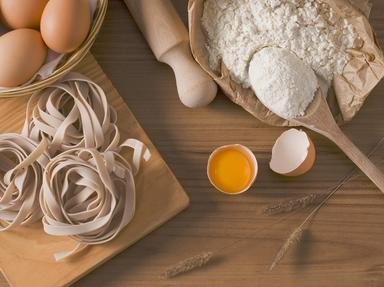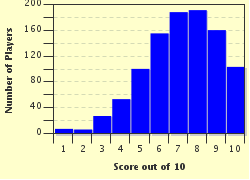Quiz Answer Key and Fun Facts
1. Chef gives you a box of oranges and asks you to make supremes. How do you do that?
2. A gambler conceals part of her winnings by skimming them to avoid paying taxes. Some milk is skim. A rock skims the water when it is thrown so as to bounce on the surface. What does a chef do when skimming?
3. Chef asks you to reorganize a part of the pantry. On one shelf, you find containers of the following: arrowroot, corn starch (cornflour in Britain), cream of tartar, kudzu powder, potato starch, tapioca starch (cassava flour) and Wondra® instantized wheat flour. Which one doesn't belong with the others?
4. Chef sees you chopping herbs with a chef's knife. She brings you a special knife with its own special cutting board and asks if you've ever tried one of these. It is a single sharpened blade in the shape of a crescent with a wooden handle on each end. The board has a shallow depression in it to contain the food being processed. Chef demonstrates by rocking the knife back and forth over the herbs and the results are impressive. What has chef just offered you?
5. Both professional kitchens and home kitchens are potential sources of food poisoning. To minimize this risk, the standard advice is to keep hot foods hot and cold foods cold. This is because pathogenic bacteria thrive between certain temperatures. What is this range of temperatures, called "the Danger Zone"?
6. Chef Kwon is visiting from the Republic of Korea and wants to introduce diners to some of the classic flavours of his country's cuisine. He thinks that it will be easier to coax people into trying these dishes if the menu describes them in familiar terms. What food to which Western diners would be accustomed is "kimchi" most like?
7. Gloria E. Anzaldúa wrote "I am an act of kneading, of uniting and joining that not only has produced both a creature of darkness and a creature of light, but also a creature that questions the definitions of light and dark and gives them new meanings." Emily Dickinson wrote that the wind kneads the grass. What is a cook doing when kneading?
8. Chef is working on an off-menu special and asks you to fetch the "Ras el hanout" for her. Where do you go to find it?
9. What do the following have in common? Russian pelmeni, Italian ravioli, Jewish kreplach, Chinese jiaozi and Swabian maultaschen.
10. Which of the following is a pure example of caramelization only?
Source: Author
FatherSteve
This quiz was reviewed by FunTrivia editor
WesleyCrusher before going online.
Any errors found in FunTrivia content are routinely corrected through our feedback system.

